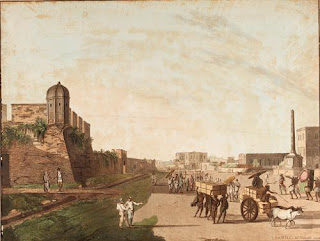Elisabetta Marabotto of Saffronart examines a selection of Daniell’s prints from some of the most exquisite museum collections in the world
London: Would you like to own something that the Victoria & Albert Museum and Royal Academy of Arts have in their collections? Well, now you can compete with them and start your own collection of museum quality Thomas Daniell prints thanks to Saffronart.
London: Would you like to own something that the Victoria & Albert Museum and Royal Academy of Arts have in their collections? Well, now you can compete with them and start your own collection of museum quality Thomas Daniell prints thanks to Saffronart.
In conjunction with the sale of nine prints by Thomas Daniell at Saffronart, this post aims to celebrate the art and success of the artist. The artworks on sale can be viewed online here (insert link).
Thomas Daniell was born in 1749 in Kingston-upon-Thames (UK) and worked as a coach painter before entering the Royal Academy Schools. He is mostly celebrated for his representations of Indian landscapes and architecture through paintings and topographical prints. His fascination for India was prompted by stories of wealth and fame awaiting travelers in India, and hence he decided to follow this path.
In 1784 the East India Company granted the artist the opportunity to travel to Calcutta as an engraver assisted by his nephew William Daniell. They spent ten years travelling around India producing sketches which Thomas then transformed into oil paintings on his return to England.
In 1799, Thomas Daniell was nominated a member of the Royal Academy of Arts and as his diploma work he used a painting of the temples at Bindrabund (Image 1). Bindrabund later renamed Vrindavan, is related to the early years of the god Krishna, and for this reason became an important pilgrimage site. The site encloses almost thousand temples, the majority of which were built in the sixteenth century. Thomas and William Daniell were impressed by this view and tried to convey the grandeur and spirituality of the site through this work.
The greatest achievement the Daniells accomplished was the publication of six volumes of aquatints titled “Oriental Scenery”, between 1795 and 1815. Each volume had twenty-four aquatints, hand-coloured so they would resemble the original works.
Thomas and William Daniell were among the first British artists to travel to India and their works introduced to Britain the new exciting and ‘exotic’ world of India.
Many museums all around the world hold collections of Thomas Daniell’s works, but to avoid reader fatigue, I have chosen just a few to explore here.
Above is one of the prints from the Victoria & Albert Museum (London) collection of Thomas Daniell. This work represents the fort at Allahabad which was built by Akbar in 1583. The Chehel Sutun (Hall of Forty pillars) was built as the pleasure pavilion in the fort. This print is extremely important because it attests the existence of a structure which is no longer extant.
The Freer Gallery of Art and Arthur M. Sackler Gallery at the Smithsonian Institute in Washington also have a good collection of Thomas Daniell’s prints which belong to the series “Views of Calcutta”.
Calcutta is the first city Thomas and William Daniell visited in India, and it is where they built their own printing studio. So, the first set of prints was mainly depicting Calcutta and its landmarks and the income from their sale was used by the Daniells to explore and travel all around India.
The Morgan Library & Museum in New York has one of Daniell’s prints created during his travels in Northern India (1788-91). The painting below (Image 5) documents the most iconic spot of the city of Gyah: the immortal banyan tree. According to the Hindus, this is thought to be connected with a more sacred tree growing in a temple underneath the earth. This work was included in the first volume of “Oriental Scenery”.
Finally, the Tate in London boasts five Daniell prints in its permanent collection. These are quite diverse, but all very evocative of the Indian landscape. The work I have chosen is a representation of the Sher Shah’s mausoleum in Sasaram, Bihar. Sher Shah was an Afghan ruler who exercised his power after the Mughals decline in the sixteenth century in Northern India. The mausoleum was built in the middle of an artificial lake and connected to the earth through a large stone bridge.
 |
| Image 6. Thomas Daniell, Sher Shah's Mausoleum, Sasaram. Oil on canvas, 1810. Image Credit: Tate, London. http://www.tate.org.uk/art/artworks/daniell-sher-shahs-mausoleum-sasaram-t01403. |
Thomas Daniell through his work managed to show British people the Indian landscape and educate them about the history and culture of the country during a time when travelling was a rare opportunity for a few selected ones.
These works visually narrate the story of sixteenth century India through the romantic and Orientalist eyes of a western artist who like many others was under the spell of India.
This is a unique chance to purchase some of Thomas Daniell’s works which bear a long and rich history.
For more information about Thomas Daniell’s museum collections mentioned in this post you can browse the Royal Academy of Arts, Victoria & Albert Museum, The Smithsonian Institution, The Morgan Library & Museum and the Tate websites.





No comments:
Post a Comment